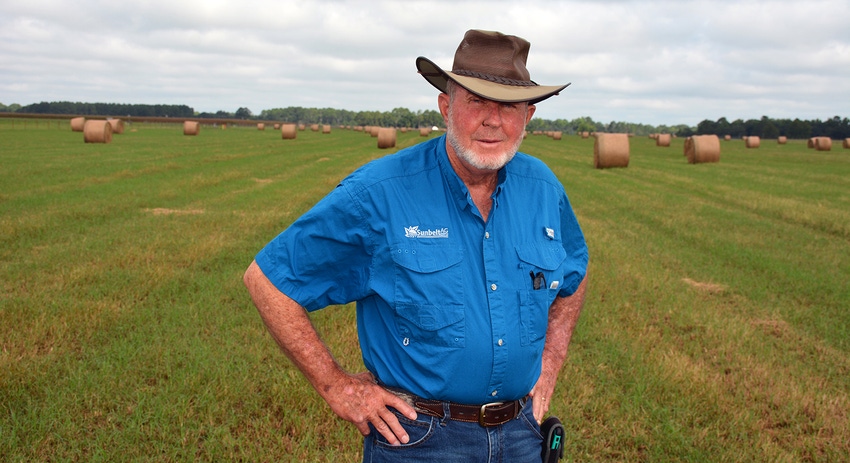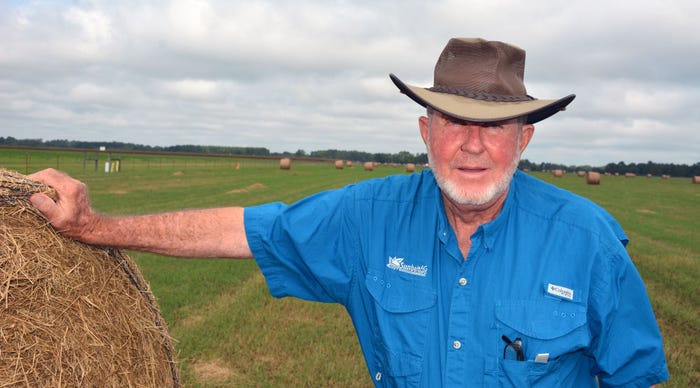
If you've been to the Sunbelt Ag Expo's popular hay demonstration site, you've seen Benjie Baldree, even if you didn't know it. And if you were a third-grader in south-central Georgia in the last two decades, or the teacher or parent of one, you might've seen him, too.
At the Expo, Baldree was the tall, lean-looking fellow with the Abe Lincoln (or Shenandoah) beard, wearing the broadbrim hat and collectively handling the walkie-talkies. His laidback but driven manner kept the moving parts of the Expo's hay demo cutting in the right direction.
The Sunbelt Ag Expo will be Oct. 19-22 in Moultrie, Ga. The show grounds and the Darrell Williams Research Farm will again be packed with all things rural.
For ten days or so prior to the annual show and during it, Baldree is the 'general' of the 100-acre hay demonstration section of the 600-acre Sunbelt Ag Expo Darrell Williams Research Farm, one of the largest hay production demo and research sites in the country.
Back in 2000, Darrell Williams, the Expo's long-serving farm manager, knew Baldree and his proven knack for steady logistics. Williams asked Baldree to start 'hanging around the hay site' when he had the time, Baldree said.
"He needed help, and we were already down here doing research work. We would talk from time to time about how he wanted to set things up with the forage demo," Baldree, 72, said during an interview at the Expo headquarters in August.
Baldree at the time was an agronomic research technician based on the University of Georgia campus in Tifton, just north of the Expo grounds. He wasn't looking for another task.
"But I guess you could say before I knew it, I was the guy looking after the hay and hay equipment during the Expo," he said with a laugh. "But from my standpoint, I saw it as another adventure. I believed in what the Expo was doing and still do."
Hay Inerest
Two decades ago, he said, the Expo hay demos maybe included 20 pieces of equipment total. Today, it can total as many as 80 pieces of equipment, including mowers, balers, rakes and tedders, demonstrating each piece of equipment twice a day each of the three days of the show.
"If someone wants to see what it is all capable of doing, this is literally the only place in the world to see it all like we're able to do. In a real-life situation, people see what they want to see and learn what they want to learn about hay production in the Southeast," he said.
In the last decade, interest in hay production has grown 'tremendously in the lower Southeast," he said. "I tell people back when I was younger, trying to grow a little bit of hay, most folks didn't know what a tedder was around here. But now hay production is a big business. People are shopping all the time for hay equipment and trying to stay ahead or increase their productive."
According to USDA data, Georgia producers managed almost 600,000 acres of hay in 2020 with average yield of three tons per acre.
Baldree grew up on the family farm in Tift County, where he still lives. He graduated from high school in 1968, and then got a two-year ag degree from the local Abraham Baldwin Agricultural College. Soon after college, he took a job at a large well-known plantation in Lee County, Ga., becoming the owner's '24/7 man.' He learned how to work for a workaholic, he said, who expected a lot.
Soon after Baldree started, the plantation owner rented an extra 1,000 acres of peanut allotment at the time on another farm. He wanted calcium samples taken from each acre of it. That was one of Baldree's assignments. He and the owner met 5:30 sharp at the local restaurant each morning for additional ones. It was a learning experience. After a short stint on the plantation, he began looking for other opportunities. His agricultural teacher, Charlie Majeski, told Baldree if he wanted another job to call Milton Walker, a research agronomist back in Tift County. Baldree called Walker.
"I knew row crops backwards and forwards, but you could say I got on-the-job training from Milton on conducting actual research-type plot work. I was young and found it interesting," he said.

Back in 2000, Baldree and some local ag champions began talking. Other than the small percentage of kids who grew up in agriculture, the majority of kids did not understand at all where their food came from, even most of the kids in south Georgia. (Brad Haire)
For years, he farmed fulltime and worked fulltime on what was back in the day called the Coastal Plain Experiment Station in Tifton, Ga.
"People remember that back in 70s and 80s it was difficult times for farming, especially row crop. And as the old saying goes, 'If you can't figure it out on paper, you might not need to try it.' I guess that's where we kind of wound up. I at least had a steady income from the university work plus what I was doing with the farming. So, it worked out pretty good," he said.
He retired from farming in 1996 and began renting out his land. He retired from research work in 2006 but soon returned as parttime technician. He's been married to Linda for 49 years. Their daughter, Stephanie, is married to Allen Peugh. Stephanie and Allen have Bryce, who is 21.
Ag Awareness
Back in 2000, the same time grandson Bryce was coming into the world, Baldree ushered in something else he says is one of his proudest accomplishments. At the time, he and some local ag champions began talking. Other than the small percentage of kids who grew up in agriculture, the majority of kids did not understand at all where their food came from, even most of the kids in south Georgia.
A lot of planning and characters helped, but all who did in the early days and later would say Baldree was and remained the driving force behind the UGA Agricultural Awareness Day, later to include Environmental in the title.
In April 2001, 60 or so third-graders from the local Omega Elementary School came to the UGA Campus in Tifton where a small core of ag specialists stood by six or so 'learning stations.' They returned in the fall as fourth-graders to the same stations. That set the plan and the pattern for two decades.
"The main thing we were trying to do was give the kids some idea of where their food and fiber came from. This business of agriculture is so fine-tuned but it's also delicate. A lot of times, not only the kids but the adults take it for granted; that we can go run in the grocery store and get anything we want to whenever we want it, but that's not necessarily the case," he said.
The ag awareness day grew to include dozens of schools from more than a half a dozen counties, all learning about agriculture and environmental lesson directly tied to their in-classroom learning modules. At its peak, the program drew more than 1,200 third-graders one April day. They returned as fourth-graders for the fall show, usually in November.
In total over the two decades, more than 10,000 students came through the ag awareness program, and that's not including the teachers and parents who also tagged along.
"I guess you do think about it at times. I've been able to do things I like to do and do things that I'm proud of and that I was happy to do really. You could say I've been very blessed," he said.
About the Author(s)
You May Also Like






